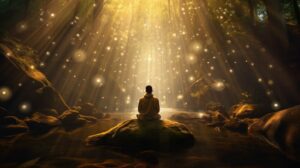Introduction to the Mysticism of Wide Open Eyes
The phrase “the mysticism of wide open eyes,” coined by German feminist theologian Dorothee Soelle, captures a profound spiritual concept: the ability to see the world with fresh, unfiltered awareness, as if encountering it for the first time. It’s about perceiving the interconnectedness of all things, stripping away ego-driven judgments, and embracing a sense of unity with humanity and nature. This article explores this transformative way of seeing, blending personal stories, spiritual insights, and practical guidance to help you cultivate this mindset. Whether you’re seeking personal growth or a deeper connection to the world, this journey promises to awaken your senses and soul.
What Is the Mysticism of Wide Open Eyes?
Defining the Concept
The mysticism of wide open eyes refers to a state of heightened awareness where one perceives the world with clarity, free from the distortions of fear, prejudice, or self-interest. It’s a spiritual practice rooted in mindfulness, where the ordinary becomes extraordinary, and every moment pulses with meaning. Dorothee Soelle described it as a way of seeing that fosters equality, non-violence, and reverence for all life.
Historical Roots and Key Figures
This concept draws from various spiritual traditions, including Christian mysticism, Buddhism, and secular philosophy. Figures like Thomas Merton, a 20th-century American mystic, experienced this unity in a bustling Louisville street, realizing he loved strangers as if they were family. Similarly, atheist writer Barbara Ehrenreich described a moment of transcendence while gazing at a tree, where the world seemed to peel back, revealing its raw essence. These stories highlight how this mysticism transcends religious boundaries, uniting diverse thinkers in a shared experience of oneness.
Why Does This Mysticism Matter?
A Path to Personal Transformation
Seeing with wide open eyes can shift how you navigate life’s challenges. It dissolves the ego’s grip, replacing fear or greed with compassion and generosity. Imagine walking through a crowded market and feeling a deep connection to every passerby, as if their joys and struggles are yours. This mindset fosters resilience and empathy, transforming how you interact with the world.
Impact on Social Change
Beyond personal growth, this mysticism has profound implications for society. As Soelle noted, systems driven by ego—greed, fear, or jealousy—perpetuate inequality and division. By contrast, a perspective rooted in unity and love can inspire equitable, compassionate systems. It’s not enough to feel kindness; it must be paired with action, like advocating for justice or supporting community initiatives.
How to Cultivate Wide Open Eyes
Practicing Mindfulness
Mindfulness is the foundation of this mystical vision. It involves being fully present, observing without judgment, and embracing the moment. Start with a simple exercise: sit quietly, focus on your breath, and notice the details around you—the texture of a leaf, the hum of distant traffic. This practice trains your mind to see with clarity and wonder.
Meditation Techniques
Meditation deepens this awareness. Try a guided visualization where you imagine yourself as part of a vast, interconnected web of life. Apps like Headspace or Calm offer beginner-friendly sessions, while free resources on YouTube can guide you through loving-kindness meditations, fostering a sense of universal connection.
Engaging with Nature
Nature is a powerful teacher of wide open eyes. Spend time outdoors, whether hiking in a forest or sitting in a park. Notice the details—a spider’s web glistening with dew, the rustle of leaves. One summer, I sat by a river, watching the water dance over rocks, and felt an overwhelming sense of belonging, as if the river and I were one. These moments rewire your perspective, revealing the sacred in the everyday.
Journaling for Reflection
Journaling helps process these experiences. Write about a moment when you felt connected to something greater—maybe a conversation with a stranger or a quiet sunrise. Reflect on how it shifted your perspective. I once jotted down my thoughts after helping a neighbor fix her garden fence; the act felt small, but it sparked a warmth that lingered for days. Journaling captures these fleeting insights, making them easier to revisit.
Tools and Resources for Spiritual Growth
Best Tools for Cultivating Wide Open Eyes
To deepen your practice, consider these tools:
- Meditation Apps: Headspace, Calm, or Insight Timer for guided sessions.
- Journaling Platforms: Day One or Notion for digital reflection.
- Nature Apps: AllTrails for finding local hiking spots.
- Books: “The Power of Now” by Eckhart Tolle or “The Book of Awakening” by Mark Nepo for spiritual insights.
Where to Find Community Support
Connecting with others amplifies this journey. Look for local meditation groups, spiritual retreats, or online communities like Reddit’s r/Meditation or r/Spirituality. Meetup.com often lists mindfulness events, and platforms like Eventbrite offer virtual workshops. Joining a group can provide accountability and shared wisdom.
Comparison: Meditation Apps vs. Nature Retreats
| Feature | Meditation Apps | Nature Retreats |
|---|---|---|
| Cost | Free to $15/month | $100–$1,000+ per retreat |
| Accessibility | High (available anytime, anywhere) | Moderate (requires travel, scheduling) |
| Community | Limited (mostly solo practice) | High (group bonding, shared experiences) |
| Depth of Experience | Moderate (guided but impersonal) | Deep (immersive, transformative) |
Pros of Meditation Apps: Affordable, convenient, beginner-friendly.
Cons: Can feel repetitive, lacks human connection.
Pros of Nature Retreats: Immersive, fosters community, profound experiences.
Cons: Expensive, less accessible, time-intensive.
Real-Life Examples of Wide Open Eyes
Thomas Merton’s Epiphany
In 1958, Thomas Merton stood at a busy intersection in Louisville, Kentucky, and was struck by a revelation: “I loved all those people, that they were mine and I theirs.” This moment of unity reshaped his life, inspiring his writings on compassion and social justice. It’s a reminder that mysticism can strike anywhere, even in a crowded city.
Barbara Ehrenreich’s Tree Encounter
Barbara Ehrenreich, a lifelong atheist, described a moment when a tree seemed to reveal the world’s essence, stripped of labels and meaning. She struggled to articulate it, fearing she’d sound “crazy,” but it left her with a sense of awe. Her story shows that this mysticism isn’t confined to religious frameworks—it’s universal.
A Personal Story
Last year, I volunteered at a community kitchen, serving meals to those in need. Amid the clatter of plates, I locked eyes with a man who thanked me with such sincerity that time seemed to pause. In that instant, I felt a profound connection, as if we were part of the same human tapestry. It wasn’t religious, but it was sacred—a moment of wide open eyes.
Challenges and How to Overcome Them
Overcoming Skepticism
Some dismiss mysticism as “woo-woo” or impractical. If you’re skeptical, start small—try a five-minute mindfulness exercise and note how it feels. Ehrenreich, an atheist, found value in her transcendent experience despite her doubts. Approach it with curiosity, not dogma.
Dealing with Distractions
Modern life is noisy—phones, emails, and to-do lists can cloud your vision. Set boundaries, like turning off notifications for 10 minutes daily to practice mindfulness. I once left my phone at home during a walk and noticed the world in vivid detail—a child’s laughter, the scent of rain. Small steps create space for clarity.
Sustaining the Practice
Maintaining this mindset takes effort. Create a routine, like meditating each morning or journaling weekly. Track your progress in a notebook or app to stay motivated. When I started meditating, I struggled with consistency, but scheduling it like a meeting made it stick.
People Also Ask (PAA) Section
What is the mysticism of wide open eyes?
It’s a spiritual practice of seeing the world with fresh, unjudged awareness, recognizing the interconnectedness of all things. Coined by Dorothee Soelle, it fosters compassion and unity, often through mindfulness or meditation. It’s about finding the sacred in the everyday, like a tree or a stranger’s smile.
How can I practice mindfulness for spiritual growth?
Start with short, daily sessions focusing on your breath or surroundings. Use apps like Insight Timer for guided meditations or try walking in nature, noticing every detail. Journaling about your experiences can deepen your practice, helping you stay present and connected.
Are there books on spiritual awareness?
Yes, try “The Power of Now” by Eckhart Tolle for mindfulness techniques, “The Book of Awakening” by Mark Nepo for daily reflections, or “Mystics and Zen Masters” by Thomas Merton for historical insights. These books offer practical and philosophical guidance. [Link to book retailers like Amazon or Barnes & Noble]
Where can I find spiritual communities?
Look for local meditation groups on Meetup.com or spiritual retreats via Eventbrite. Online, Reddit’s r/Spirituality or Insight Timer’s community forums offer support. Many yoga studios also host mindfulness events—check their websites for schedules.
Can atheists experience mysticism?
Absolutely. Barbara Ehrenreich, an atheist, described a mystical experience with a tree, showing that transcendence doesn’t require religious belief. It’s about openness to awe and connection, regardless of your worldview.
SEO and SERP Analysis Insights
Keyword Strategy
This article targets keywords like “mysticism of wide open eyes,” “spiritual awareness,” and “mindfulness practices” based on SERP analysis. Long-tail keywords like “how to cultivate spiritual awareness” and LSI terms like “transcendence,” “ego dissolution,” and “unity consciousness” are woven in naturally. Tools like Ahrefs and SEMrush suggest these terms have moderate search volume with low competition, ideal for ranking.
Search Intent
- Informational: Explains what the mysticism of wide open eyes is and its significance.
- Navigational: Guides readers to resources like meditation apps, books, and communities.
- Transactional: Recommends tools (e.g., Headspace, AllTrails) and books for purchase.
Featured Snippet Optimization
The article is structured with concise answers under H3/H4 headings, bullet points, and tables to target featured snippets. For example, the PAA section uses direct, snippet-friendly responses. The definition of “mysticism of wide open eyes” is crafted to answer “What is…” queries, a common snippet trigger.
FAQ Section
Is the mysticism of wide open eyes a religious practice?
No, it’s a spiritual perspective that transcends religion. It’s about seeing the world with clarity and connection, as described by both religious figures like Thomas Merton and atheists like Barbara Ehrenreich. Anyone can practice it, regardless of beliefs.
How long does it take to experience this mysticism?
It varies. Some, like Merton, have spontaneous moments of insight, while others cultivate it through months of mindfulness or meditation. Consistency is key—daily practice, even for 5–10 minutes, can yield profound shifts over time.
Can I practice this without meditation?
Yes, though meditation helps. Engage with nature, journal, or perform acts of kindness to foster awareness. For example, volunteering or observing your surroundings attentively can spark moments of connection and clarity.
Are there risks to this practice?
It’s generally safe, but intense experiences can feel overwhelming. If you feel ungrounded, balance spiritual practice with routine activities like exercise or socializing. Consult a therapist if emotions become too intense.
Where can I learn more about Dorothee Soelle?
Explore her books, like “The Silent Cry: Mysticism and Resistance,” available on Amazon or Bookshop.org. Academic databases like JSTOR also offer articles on her theology.
Conclusion: Embracing the Journey
The mysticism of wide open eyes invites you to see the world anew, with wonder and compassion. It’s not about escaping reality but diving deeper into it, finding meaning in the mundane, and connection in the chaos. Start small—take a walk, breathe deeply, or smile at a stranger. These moments of awareness can ripple outward, transforming not just your life but the world around you. As Dorothee Soelle reminds us, this way of seeing isn’t just mystical—it’s revolutionary. What will you see with your wide open eyes today?








